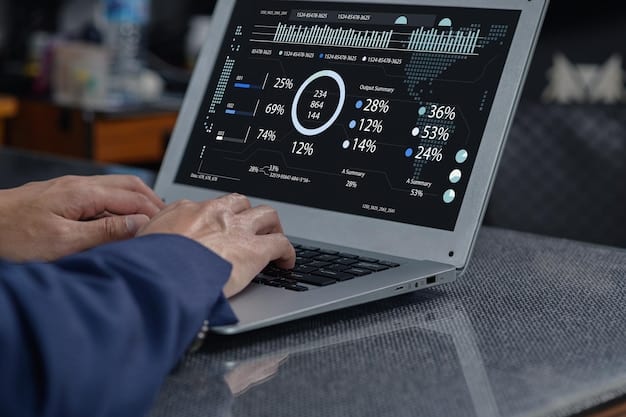Understanding Cloud Service Level Agreements (SLAs) in the US Market

Understanding Cloud Service Level Agreements (SLAs) in the US market is crucial for businesses leveraging cloud services, as these agreements outline the provider’s commitments regarding service availability, performance, and support, ensuring businesses receive the expected level of service and can hold providers accountable.
Understanding Cloud Service Level Agreements (SLAs) in the US market is essential for any business utilizing cloud services. These agreements act as a contract, setting expectations and providing recourse if those expectations aren’t met. Let’s delve into what you need to know about SLAs in this context.
What is a Cloud Service Level Agreement (SLA)?
A Cloud Service Level Agreement (SLA) is a crucial component of any cloud service contract. It’s essentially a guarantee, outlining the level of performance, availability, and support a cloud provider promises to deliver. Failing to understand your SLA can lead to unexpected costs and disruptions.
Think of an SLA as a detailed roadmap. It defines the responsibilities of both the cloud provider and the customer, setting clear expectations and providing a framework for resolving potential issues.
Key Components of a Cloud SLA
A well-defined Cloud SLA should cover various important aspects. It’s not just about uptime; it’s about the overall quality and reliability of the service.
- Service Availability: The percentage of time the service is accessible and operational. This is often expressed as a “9s” guarantee (e.g., 99.9% uptime).
- Performance Metrics: Specific measurements of service performance, such as response time, throughput, and latency.
- Support Response Times: The time it takes for the provider to respond to support requests and resolve issues.
- Security Measures: Details on the security protocols and practices implemented to protect data and prevent unauthorized access.
Furthermore, the SLA should clearly define the consequences of failing to meet these commitments, including penalties and remedies.

To summarize, understanding the key components of a Cloud SLA is vital for ensuring your cloud services meet your business requirements and that you have recourse if performance falls short.
Why are SLAs Important in the US Cloud Market?
In the highly competitive US cloud market, SLAs play a vital role in differentiating services and building trust between providers and customers. They’re more than just legal documents; they’re statements of commitment. They offer a level of assurance in a market where options are abundant and choices are intricate.
Given the increasing reliance on cloud computing for critical business operations, SLAs have become essential for managing risk and ensuring business continuity.
Legal and Compliance Considerations
SLAs in the US market are significantly influenced by legal regulations and compliance standards. The agreement must align with industry-specific mandates.
- HIPAA Compliance: For healthcare organizations using cloud services, the SLA must demonstrate compliance with the Health Insurance Portability and Accountability Act (HIPAA) for safeguarding patient data.
- GDPR Implications: If a US-based company provides cloud services to EU citizens, the SLA needs to address General Data Protection Regulation (GDPR) requirements related to data privacy and security.
- State-Specific Data Laws: Different US states have their data protection laws, such as the California Consumer Privacy Act (CCPA). SLAs should reflect compliance specific to the state in which the customer operates.
Consequently, it’s not just about the broad agreement; it’s about the detailed adherence to specific legal frameworks operating in the US.
In conclusion, understanding the legal and compliance factors associated with SLAs in the US market is vital for both cloud providers and consumers to avoid legal complications and maintain customer trust.
Understanding Key SLA Metrics and Definitions
To effectively evaluate a Cloud Service Level Agreement (SLA), it’s vital to understand the key metrics and definitions used to measure and define service performance. These metrics provide a quantitative basis for assessing whether the provider is meeting its commitments.
Here are some of the most common and important metrics found in cloud SLAs:
Common SLA Metrics
Various parameters are used to measure performance. Knowing what to look for makes all the difference.
- Uptime Percentage: This is the most widely recognized metric, indicating the percentage of time the service is available. SLAs often guarantee uptimes of 99.9% or higher.
- Response Time: The time it takes for a service to respond to a request. This applies to various aspects of a service, such as accessing data or executing a function.
- Throughput: Measures the amount of data processed or the number of transactions completed within a specific period. This is crucial for applications that require high data processing capabilities.
Furthermore, the SLA should offer clear definitions of how these metrics are measured and reported. This transparency is essential for effective monitoring and dispute resolution.

In short, a firm understanding of key SLA metrics and how they are defined is critical in evaluating the value and effectiveness of a cloud service agreement.
Negotiating and Customizing SLAs in the US
Negotiating and customizing SLAs is a critical aspect of ensuring that the cloud services you acquire meet your specific business requirements. Standard SLAs, drafted by the provider, may contain terms that aren’t ideal for your particular use case.
Therefore, don’t hesitate to negotiate terms and customize the SLA to align more closely with your unique needs and priorities.
Tips for Effective Negotiation
Negotiation, while often daunting, is an essential part of securing a fair and beneficial SLA. The following tips can help:
- Clearly define your requirements before entering negotiations.
- Understand the provider’s limitations and constraints.
- Negotiate metrics that are meaningful to your business and key workloads.
- Seek legal counsel to review the agreement and ensure it protects your interests.
In a word, never accept the initial offer; engage in a well-informed negotiation to achieve a mutually beneficial agreement. When possible, you should also consult with legal professionals to navigate the agreement legally.
In conclusion, active negotiation and customization of SLAs are essential for ensuring that your cloud services fully support your business objectives and risk management strategies.
Monitoring and Enforcing SLAs: What to Do When Things Go Wrong
Monitoring and enforcing SLAs are vital steps to ensure cloud providers are held accountable for the agreed-upon level of service. Even the best-negotiated SLA is worthless if it’s not actively monitored and enforced.
These steps help to preserve the integrity of the agreement. This includes regular checks and clear protocols when things do not go as planned.
Steps for Effective Monitoring and Enforcement
To effectively monitor and enforce your SLA, take the following actions:
- Implement robust monitoring tools to track key service metrics in real-time.
- Regularly review performance reports provided by the cloud provider.
- Establish clear communication channels for reporting and resolving service issues.
- Document all incidents and outages, including their impact on your business.
Remember, proactive monitoring and enforcement help to mitigate risks and ensure you receive the expected value from your cloud services.
In summary, monitoring and enforcing SLAs are crucial to maintaining the integrity of your agreement and ensuring that you receive the level of service you’re paying for.
Future Trends in Cloud SLAs in the US Market
The landscape of Cloud Service Level Agreements (SLAs) is continuously evolving, and several trends are reshaping how these agreements are structured and managed. Staying abreast of these trends is essential for both cloud providers and consumers to adapt to the changing market dynamics.
Here are some of the key trends expected to shape cloud SLAs in the US market:
- AI-Powered Monitoring: AI and machine learning will be increasingly integrated into cloud monitoring tools, offering real-time anomaly detection and predictive analysis of performance issues.
- Dynamic SLAs: Traditional SLAs tend to be static, but there’s a move towards dynamic SLAs that adjust based on real-time conditions and business needs.
- Focus on Sustainability: As environmental concerns grow, SLAs will likely include clauses related to the cloud provider’s commitment to sustainability and energy efficiency.
In short, understanding future trends in cloud SLAs will help businesses make informed decisions about cloud adoption and management.
| Key Aspect | Brief Description |
|---|---|
| ✅ Uptime Guarantee | Ensures minimum service availability, often 99.9% or higher. |
| ⏱️ Response Time | Measures service responsiveness to requests. |
| 🛡️ Security Measures | Details protocols for data protection and prevent unauthorized access. |
| 🤝 Compliance | Adherence to HIPAA, GDPR, and state-specific data laws. |
Frequently Asked Questions
▼
Uptime typically refers to the percentage of time a system is operational, while availability considers factors like redundancy and failover mechanisms, making it a broader metric of reliability.
▼
You can measure the effectiveness of your SLA by regularly monitoring key metrics, reviewing performance reports, and assessing the provider’s responsiveness to issues or incidents.
▼
If your cloud provider violates the SLA, document the incident, notify the provider, and follow the dispute resolution process outlined in the agreement. Seek compensation if applicable.
▼
While some cloud providers offer standardized SLAs, many are willing to negotiate and customize the terms to better align with a customer’s specific needs and requirements.
▼
It is advisable to review your cloud SLA periodically, especially when your business needs change or when the cloud provider introduces new services or features, to ensure it remains relevant.
Conclusion
In conclusion, understanding Cloud Service Level Agreements (SLAs) in the US market is vital for businesses to ensure they receive the expected level of service, maintain compliance, and mitigate potential risks. By carefully negotiating, monitoring, and enforcing these agreements, organizations can maximize the value of their cloud investments and protect their interests in an ever-evolving cloud landscape.





